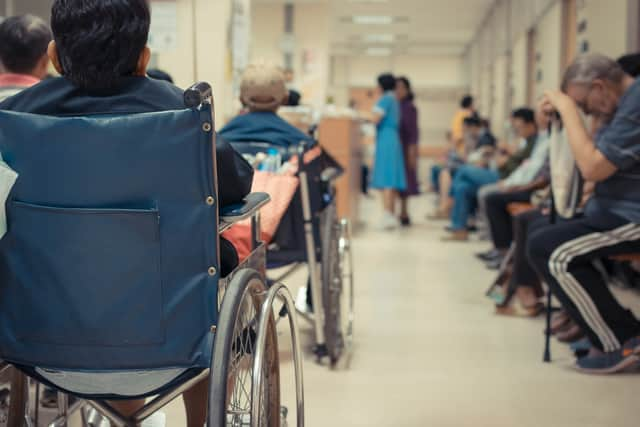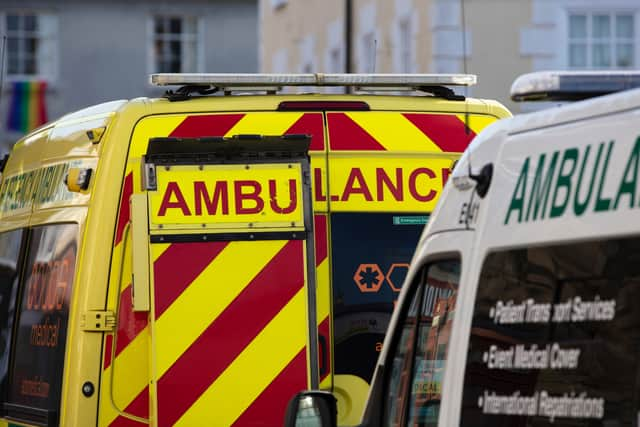NHS pressures reach record levels - how Greater Manchester hospitals are coping with beds and A&E times
and live on Freeview channel 276
As the NHS faces record levels of pressure on it, we’ve taken a look at how Greater Manchester’s health service is coping.
The latest figures from NHS England, analysed by our data team at NationalWorld, showed the health service in England faced the highest levels of pressure on record in a number of key areas including bed occupancy levels and ambulance call-outs.
Advertisement
Hide AdAdvertisement
Hide AdThere were also record levels of patients with respiratory illnesses in hospital as the NHS faced surging flu cases and large numbers of patients with Covid-19. However, in one glimmer of light for the embattled health service waiting lists fell for the first time since the start of the pandemic. We’ve looked at all the key statistics available for to see how Greater Manchester hospitals compared to the picture across England as a whole.
What is happening with bed occupancy levels in hospitals?
Bed occupancy in hospitals reached record levels across England in the week up to 8 January, while more than 14,000 patients were in hospital even though they were medically fit to be discharged, which is also the highest figure recorded. Throughout December more than nine out of 10 hospital beds in England were occupied.
In Greater Manchester there were hundreds of patients in hospital even though medically they were fit to leave in the latest week of data (up to 8 January). Across the Northern Care Alliance’s four hospitals 300 people were in hospital even though they no longer met the medical criteria for being there.


Across Greater Manchester’s five hospital trusts only one saw a reduction of people in hospital when they had no need to be there in the latest week compared to the previous one (ending 1 January). And at Wrightington, Wigan and Leigh (WWL) NHS Foundation Trust there was an 18.6% increase in beds occupied by patients who didn’t need to be hospital.
Advertisement
Hide AdAdvertisement
Hide AdManchesterWorld recently looked at data showing numerous hospitals in the region above the recommended safe occupancy levels set down by health bodies. WWL was completely full in this week of statistics.
What is happening with the ambulance service?
Ambulance services are equally under pressure, with more of the most serious category one calls registered in December than at any other time on record. There were more than 101,000 of these calls in the final month of 2022. Call handlers also took more 999 calls in December than in any previous month, with 1,014,489. For comparison, this is up a fifth on the 845,524 calls received in the last pre-pandemic December in 2019.
Regional ambulance figures are for the North West as a whole, rather than for Greater Manchester specifically, but they show across the region there were 11,001 category one calls received in December.
The average response time for the North West Ambulance Service (NWAS) was nine minutes and 58 seconds, missing the seven-minute target ambulance trusts are expected to meet. Every one of the ambulance trusts in England missed this target and there has been serious concerns expressed about the pressure on ambulance services and the result of this for people with heart attacks, strokes and other medical emergencies where time is of the essence.
What is happening with A&E waiting times and NHS waiting lists?
Advertisement
Hide AdAdvertisement
Hide AdAcross Greater Manchester hospital trusts are struggling to hit their target of getting 95% of patients seen by medical professionals within four hours of them arriving. Accident and emergency departments as a whole are under pressure, with record numbers of patients attending across England in December.
Bolton NHS Foundation Trust was way below this with fewer than half of A&E patients in December getting transferred, discharged or admitted within the four-hour target. At Stockport NHS Foundation Trust it was 51.4%, while at Manchester University NHS Foundation Trust it was 51.6%, at the Northern Care Alliance it was 53% and at Tameside and Glossop it was 57.8%.
Numbers of patients attending A&E in November and December 2022 were broadly similar across the region, with some hospital trusts seeing slight increases in patients and others seeing small decreases.
Across Greater Manchester tens of thousands of patients are also on waiting lists for treatment although these are now beginning to fall at some trusts. NHS England says that overall waiting lists are now getting smaller for the first time since the start of the Covid-19 pandemic in spring 2020.


Advertisement
Hide AdAdvertisement
Hide AdThe Northern Care Alliance, Stockport and WWL both saw small decreases on the waiting list in November 2022 compared to the previous month, although Bolton, The Christie and Tameside and Glossop saw small increases.
The Northern Care Alliance, which includes Salford Royal, had 147,756 people on its waiting list at the last count, of whom 17,670 have been waiting for more than a year.
The national average waiting time to start treatment is 13.6 weeks. In Greater Manchester only Bolton and The Christie are currently achieving better than this.
The NHS has now written to hospital trusts asking them to book in all remaining patients who have been waiting more than 18 months for their appointment or treatment by the end of March.
What has NHS England said?
Advertisement
Hide AdAdvertisement
Hide AdNHS England says its staff have also been contending with record levels of respiratory illnesses this year. Across England there were 7,273 beds taken up by patients with Covid-19 on average and 2,925 taken up by flu patients in December. This is in comparison to 33 flu patients and 7,055 Covid patients in December 2021. This has been dubbed the ‘twindemic’ by the NHS.
NHS national medical director, Professor Sir Stephen Powis, said: “As staff responded to record A&E attendances, 999 calls and emergency ambulance call outs as the ‘twindemic’ lead to unprecedented levels of respiratory illness in hospital, they also continued to deliver for patients with more people than ever before receiving diagnostic tests and cancer treatment.
“These figures show just how hard our staff are working, not only in the face of extreme pressure but also in bringing down the covid backlogs and checking more people for cancer than ever before in one month.
“The NHS will keep its foot on the accelerator to continue to make progress on the covid backlog and hospitals have today been asked to ensure anyone waiting longer than 18 months has their treatment booked in before March.
Advertisement
Hide AdAdvertisement
Hide Ad“While services continue to be pressured, it’s important the public continue to play their part by using the best services for their care – using 999 in an emergency and otherwise using 111 online and by getting their vaccinations if eligible.”
